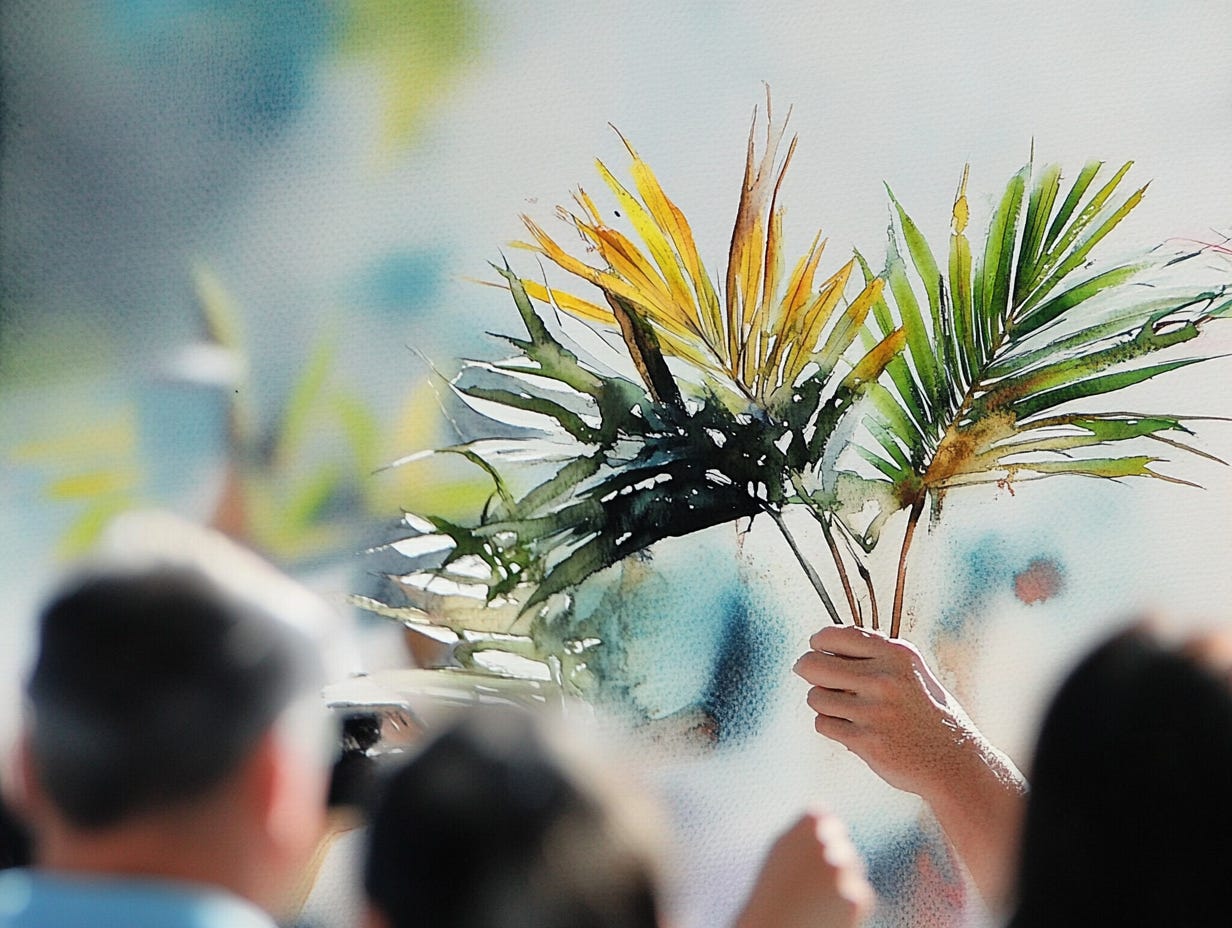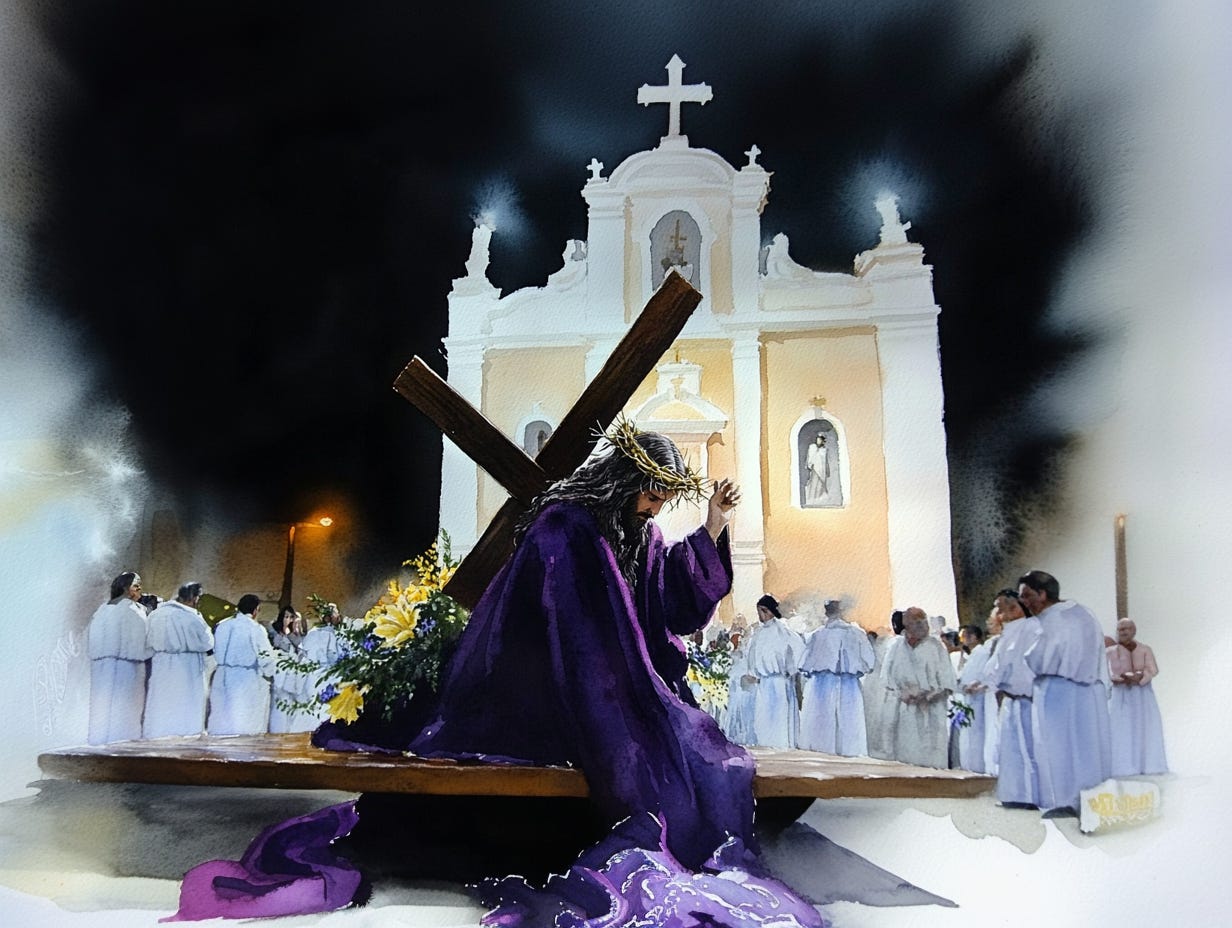Our Spring Break (Part 1): The Sacred Season
How Holy Week transformed our small Brazilian town into something electric
In American cities, spring break means beaches and bad decisions.
In my hometown of Lagoa Dourada, it meant Holy Week—when the streets filled with processions, and even the air felt different.
Candlelight. Incense. Murmured prayers and careful outfits. And in its own way, it was just as intense.
The week kicked off with Palm Sunday. I watched the first procession from my grandmother’s balcony, right next to Rosario’s Church. People passed below like a tide, carrying palm branches, whispering prayers I could barely hear but somehow felt in my chest. That moment marked the beginning of the sacred, and the unofficial start of our social season.
From then until Easter, the whole town moved differently.
Slower. Charged.
Each evening brought another procession. Candlelight flickered against colonial facades. The air filled with the scent of old wood and frankincense. Church bells rang a little longer. People dressed better, walked with purpose, spoke in reverent tones, even outside the church.
It was like the whole town had agreed to become devout together.
But reverence, I learned, had its own kind of electricity.
Families who had moved away returned for the week. Cousins arrived from São Paulo and Belo Horizonte, crowding into small houses with big stories. The local clothing shops, usually quiet, buzzed with people searching for something new to wear. Even devotion had a dress code. You couldn’t be seen in the same outfit as last year, especially with your third cousin from the city watching.
The women in the family spent an entire afternoon ironing dresses, the ones reserved for important church occasions.
“Stand up straight during the processions,” my grandmother told me. “People notice everything.”
And she was right. In a town of twelve thousand, being noticed was both the fear and the goal.
Between daily masses and evening rituals, my friends and I carved out our own flow. We lingered after church, pretending to admire the flowers while secretly scanning the crowd. We walked the square a little slower, hoping to cross paths with someone interesting. Out-of-town boys showed up like plot twists, and we obsessed accordingly.
“Did you see him? The tall one with green eyes?”
“He’s staying at his aunt’s house until Monday.”
“His name is Roberto. He goes to private school in the capital.”
One glance could fuel a week’s worth of speculation. One smile could carry you through the whole season.
By Thursday, everything felt saturated: prayer, tension, desire, restraint. It was like we’d all been walking around with our breath half-held. Teenagers tried to look holy while their hearts raced every time someone new walked through the church doors.
And then came Good Friday.
That night, the streets turned solemn. The lights were dimmed, and the town transformed. A full cast of biblical figures walked in silence: Moses, Roman soldiers in makeshift armor, barefoot women in veils, children carrying candles. Deep purple fabric was everywhere, trimmed in gold thread that shimmered softly in the dark.
The moon was out. So were the stars.
You could hear the pace of it: the steady sound of feet on the cobblestones, like a heartbeat that belonged to all of us. No one talked. No one even cleared their throat. We just watched.
And then Verônica stepped forward.
She wore a black cloak, her face covered. She stood on a small wooden platform and lifted a white cloth edged with embroidery, the face of Christ in the center, somehow alive in that candlelight.
Edilene was playing Saint Veronica—the woman who, according to tradition, stepped out from the crowd on the road to Calvary to wipe the face of Jesus. This was her moment in the procession.
Her father was a local musician, known for playing in a style that kept older regional traditions alive through families with deep roots in Brazil’s Afro-descendant culture. His music had weight. So did hers.
Edilene sang O vos omnes.
O vos omnes
qui transitis per viam,
attendite et videte
si est dolor similis sicut dolor meus.
Her voice filled the silence like water in a vessel. Pure. Unhurried. Each note seemed to hang in the air just a moment longer than expected, as if the night itself was listening.
And all the while, the church bell rang its funeral cadence: heavy, echoing across the hills. One note at a time. Like it was answering her.
There was no applause. No movement. Just the sound of her voice, the flicker of candles, the toll of the bell, and the soft night holding everything in place.
When she stepped down, the cloth still held in her hands, the procession continued.
And we began to move again—toward the night, toward home, and toward whatever might finally break loose the next day.
✶ This essay is part of From the Beginning, a personal series built from my diaries, one memory at a time. You’re reading 1998. Each piece revisits the girl I was, the world I came from, and the details I didn’t know I was already saving.
Next…
Our Spring Break (Part 2): The Release
After forty days of Quaresma—Lent—when parties were considered sinful, when the priest might be tipped off about any gathering and call it out on the church megaphone (“End that party, it’s a sin!”)—we were more than ready.




